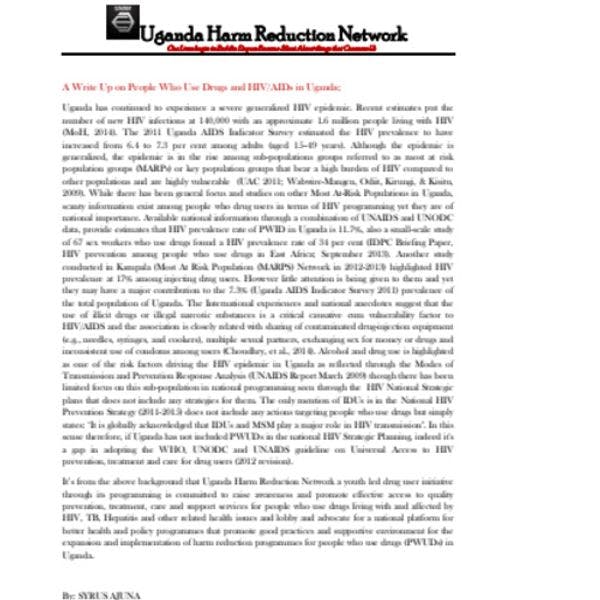A write up on people who use drugs and HIV/AIDS in Uganda
Syrus Ajuna, Ugandan Harm Reduction network
Uganda has continued to experience a severe generalized HIV epidemic. Recent estimates put the number of new HIV infections at 140,000 with an approximate 1.6 million people living with HIV (MoH, 2014). The 2011 Uganda AIDS Indicator Survey estimated the HIV prevalence to have increased from 6.4 to 7.3 per cent among adults (aged 15–49 years). Although the epidemic is generalized, the epidemic is in the rise among sub-populations groups referred to as most at risk population groups (MARPs) or key population groups that bear a high burden of HIV compared to other populations and are highly vulnerable (UAC 2011; Wabwire-Mangen, Odiit, Kirungi, & Kisitu, 2009). While there has been general focus and studies on other Most At-Risk Populations in Uganda, scanty information exist among people who drug users in terms of HIV programming yet they are of national importance. Available national information through a combination of UNAIDS and UNODC data, provide estimates that HIV prevalence rate of PWID in Uganda is 11.7%, also a small-scale study of 67 sex workers who use drugs found a HIV prevalence rate of 34 per cent (IDPC Briefing Paper, HIV prevention among people who use drugs in East Africa; September 2013). Another study conducted in Kampala (Most At Risk Population (MARPS) Network in 2012-2013) highlighted HIV prevalence at 17% among injecting drug users. However little attention is being given to them and yet they may have a major contribution to the 7.3% (Uganda AIDS Indicator Survey 2011) prevalence of the total population of Uganda.
The International experiences and national anecdotes suggest that the use of illicit drugs or illegal narcotic substances is a critical causative cum vulnerability factor to HIV/AIDS and the association is closely related with sharing of contaminated drug-injection equipment (e.g., needles, syringes, and cookers), multiple sexual partners, exchanging sex for money or drugs and inconsistent use of condoms among users (Choudhry, et al., 2014). Alcohol and drug use is highlighted as one of the risk factors driving the HIV epidemic in Uganda as reflected through the Modes of Transmission and Prevention Response Analysis (UNAIDS Report March 2009) though there has been limited focus on this sub-population in national programming seen through the HIV National Strategic plans that does not include any strategies for them. The only mention of IDUs is in the National HIV Prevention Strategy (2011-2015) does not include any actions targeting people who use drugs but simply states: ‘It is globally acknowledged that IDUs and MSM play a major role in HIV transmission". In this sense therefore, if Uganda has not included PWUDs in the national HIV Strategic Planning, indeed it's a gap in adopting the WHO, UNODC and UNAIDS guideline on Universal Access to HIV prevention, treatment and care for drug users (2012 revision).
Keep up-to-date with drug policy developments by subscribing to the IDPC Monthly Alert.
